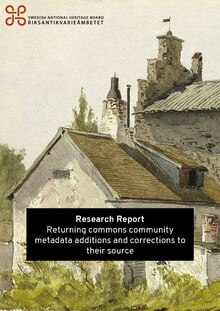GLAM/Newsletter/February 2019/Contents/Special story
|
Wikimedia Commons Data Roundtripping
Unknown actor, Hildur Engström and Julia Caesar in the revue Hertiginnan av Danviken at Kristallsalongen 1906. Photograph 1906 by Anton Blomberg (1862–1936), Scanned glass negative, Swedish Performing Arts Agency, Public Domain.
When GLAMs upload media to Wikimedia Commons and volunteers add and correct the metadata, the information is rarely read back to the originating institution. Now that Structured Data for Commons is making editing and reading metadata much easier, it can be expected that there will be many more apps and tools to play around with and enrich the openly available media. The institutions will be able to take advantage of the cumulated knowledge, with new tools to read that data back to the intitutions’ own collection systems alongside their own data. This is what we call data roundtripping.
Research


The research also looked at how institutions are taking advantage of authority data as a way of linking across collections, and whether Wikimedia projects could leverage that capacity.
Collections managers from Swedish Performing Arts Agency and The Nordic Museum in Sweden, and Sound and Vision in the Netherlands were further interviewed. Some of the envisioned opportunities grew more significant than others through the interviews:
- Adding translations of descriptive texts into other languages
- Identifying people, names and aliases, locations and subject matter
- Linking to authority data and using it to retrieve third party contributions from other memory organisations
Data Roundtripping pilots
The Wikimedia Commons Data Roundtripping project will prototype a tool that addresses these three issues. Each functionality of the tool is developed in collaboration with a museum.
Swedish Performing Arts Agency's pilot is created around an upload of 1200 glassplate photographs. Earlier they have translated all descriptions of images into English before uploading them to Wikimedia Commons. In the pilot the images will be uploaded with Swedish descriptions only. They are translated in a translation campaign and the translations are fed back to Swedish Performing Arts Agency's collections management system.
The purpose of the pilot with Nationalmuseum is to take advantage of authority IDs that have been added to the institution's contributions in Wikidata by the users. The institution is interested in collecting the Wikidata IDs themselves and ULAN IDs found in the Wikidata entries. This will aid Nationalmuseum to get additional information about artists in their collections.
The topic of The Nordic Museum’s pilot is to record metadata of the imagery from their exhibition about British fashion. The audience is invited to describe the exhibition pieces in a description campaign. This enriched information is ingested into The Nordic Museum’s collections management system as multilingual Wikidata tags.
Creators
Project by The Swedish National Heritage Board
Project team Albin Larsson, Swedish National Heritage Board, Lead Developer and Product Owner · Susanna Ånäs, Project Administrator (contractor) · Maarten Zeinstra, Researcher (contractor) · Paweł Marynowski, Software Developer (contractor)
Partnering institutions Swedish Performing Arts Agency / David Jansson, Marianne Seid · The Nordic Museum / Aron Ambrosiani · Nationalmuseum / Karin Glasemann
Further information
- The research report Research Report – Returning commons community metadata additions and corrections to source by Maarten Zeinstra / IP Squared
- Mid-term report
- Project page
- Albania report
- Australia report
- Belgium report
- Brazil report
- Canada report
- Côte d'Ivoire report
- Denmark report
- France report
- Italy report
- Mexico report
- Netherlands report
- Poland report
- Serbia report
- Sweden report
- Switzerland report
- UK report
- USA report
- Special story
- Wikipedia Library report
- Wikidata report
- Wikimedia and Libraries User Group report
- WMF GLAM report
- Calendar



